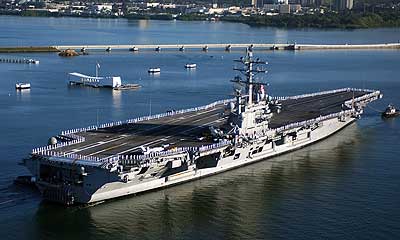December 07, 2006
As most of you know, it is a naval tradition for sailors to line the deck of a carrier when passing U.S.S. Arizona and also Mt. Vernon.

I visited the Arizona Memorial once. (It's where I learned that "quay" is prononced "key.") For those who haven't yet, you definitely should go see it. The National Park Service runs the museum onshore, and before you get on the ferry to the memorial, they make you watch a movie about the attack. It's a good idea because it puts everybody in a somber mood before they go to the memorial.
When you get on the ferry boat, they make a big deal about how you are no longer in the custody of the Park Service; now the Navy is in charge, which makes you even more respectful by the time you step onto the memorial. It is a cemetary after all.
The group I was with was very quiet while on the memorial, as I imagine most visitors are. It was a beautiful day, and all you could hear was the flapping of the American flag overhead or the occasional clang of the line against the flagpole. When you look over the side, you really can see the Arizona, only a few feet below the water's surface. And there really is oil coming out of her after all these years. And inside still, are the men. They died sixty-five years ago today.
Pearl Harbor Trivia: Bonus points go to whoever can name the ship that survived Pearl Harbor, only to be sunk by a British torpedo!
Posted by: annika at
11:09 PM
| Comments (8)
| Add Comment
Post contains 278 words, total size 2 kb.
December 02, 2006
At 1700 on the evening of December 2 a telegram arrived aboard Nagato . . . directing the opening of certain sealed top secret envelope. As his eager fingers tore open the seals, [Adm. Matome] Ugaki sensed that he had in his hands the orders he had awaited impatiently. His instinct was correct. Down the page ran the words "Our Empire has decided to go to war against the United States, England, and Holland early December." Ugaki immediately sent a message to the commanders in chief of each fleet: "Decision made, but date and time will be ordered later."The next morning, Admiral Ugaki sent out the second most famous Japanese coded message of the war, "Climb Mount Niitaka, 1208," which meant that the attack would begin on December 8, 1941 (Japan time).[Adm. Chuichi] Nagumo had been even more than usually concerned with security that day. At 0730 he signaled his ships:
This force is already in the anticipated scouting areas from Kiska and Midway Islands. Tonight we will pass the 180 degree line and near the enemy zone. More strict air alert and strict lookout against enemy ships suspected of tracking us will be maintained. Particular attention will be paid not to reveal any light at night and to limit blinker signals as much as possible.Now, on receipt of the "Go" signal, Nagumo knew that he would have to push forward on this gambler's venture he had so dreaded.
Meanwhile on the other side of the world, the German Wermacht had cut off Leningrad from the rest of Russia. They had been unable to take the city and now the first winter of the long seige had begun. Neurobiologist Alexei Alexeivich Ukhtomsky was one of the leading Soviet scientists of his day. Also a devout Russian Orthodox, he would not survive the seige of Leningrad.
From Harrison E. Salisbury's harrowing The 900 Days:
Ukhtomsky was sisty-six years old when the war broke out. He had just completed editing his lectures on the nervous system for the University of Leningrad publishing house and was planning in the 1941-42 academic year to offer a new course in physiology. With the onset of war he put aside these occupations . . . His laboratory and institute were packed up and shipped to Elabuga in the Tatar Republic and Sratov, but he himself refused to go. His lifelong associate, Nadezhda Ivanovna Bobrovskaya, was critically ill; she had suffered a brain hemorrhage on June 6, and he was caring for her in his apartment. Moreover, his own health was extremely bad. . . .Professor Ukhtomsky finally succumbed to his illnesses and starvation on August 31, 1942.Nonetheless, he refused to be evacuated with his laboratory. Nadezhda Bobrovskaya died September 26, but Ukhtomsky still refused to go. . . .
"I remain in Leningrad," he said, "in order to finish my work. I haven't long to live. I will die here. It's too late to leave."
The university organized a meeting on December 2 to mark the fiftieth anniversity of Lenin's graduation. It was held in the assembly hall. The electricity was working. From somewhere flowers had been produced for the platform. But the windows were broken, icy winds filled the chamber, and there were snowdrifts on the floor. Air-raid sirens sounded during the meeting, and there were occasional explosions of German shells.
Although he was now suffering from emphysema, although his toes were gangrenous and his cancer much worse, Ukhtomsky spoke with such vigor that participants counted his address one of his most striking.
. . .
So the intellectual life of Leningrad went on; so the intellectuals kept to their laboratories and their libraries, dying by the hundreds but making no concession to the terrible enemies which threatened their existence.
Posted by: annika at
03:28 PM
| No Comments
| Add Comment
Post contains 642 words, total size 4 kb.
60 queries taking 0.042 seconds, 146 records returned.
Powered by Minx 1.1.6c-pink.









